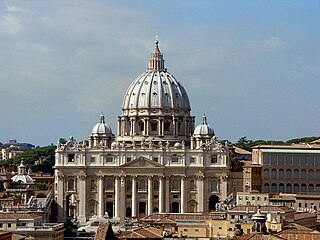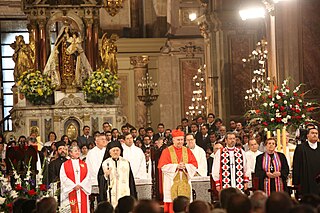Gravissimum educationis is the Second Vatican Council's Declaration on Christian Education. It was promulgated on 28 October 1965 by Pope Paul VI, following approval by the assembled bishops by a vote of 2,290 to 35.
The document is generally referred to, not by its English-language title, "Declaration on Christian Education", but by the opening words of its original Latin text, which mean "extremely important education". [1]
The document quotes at length from Divini illius Magistri (That divine teacher, 1929) by Pope Pius XI. [2]
"Since parents have given children their life, they are bound by the most serious obligation to educate their offspring and therefore must be recognized as the primary and principal educators. This role in education is so important that only with difficulty can it be supplied where it is lacking. Parents are the ones who must create a family atmosphere animated by love and respect for God and man, in which the well-rounded personal and social education of children is fostered. Hence the family is the first school of the social virtues that every society needs." [3]
On October 28, 2015, Pope Francis founded the Gravissimum Educationis Foundation [4] intended to further scientific and cultural objectives aimed at promoting Catholic education in the world. [5]
The Foundation consists of: [6] the President and the Vice President; the Board of Directors; the Secretary-General; the Treasurer; the Scientific Committee; the Assembly of Sponsors; the Board of Auditors.
The Foundation is a not-for-profit, and pursues scientific and cultural aims to promote Catholic education in the world. In particular, the Foundation is committed to: the promotion of research, studies and publications on the thought of the Church as it concerns Catholic education and culture at the school and university levels; the support and organization of conferences and international scientific events on specific issues and projects; to award institutions and scholars who have distinguished themselves in their scientific activity and/or research as it relates to Catholic education and culture; networking and collaboration between educational institutions with regard to management training and qualification and to communication of new scientific discoveries and research; the strengthening of relationships and cooperation between international organizations and institutions dedicated to education. [7]
The Roman Curia comprises the administrative institutions of the Holy See and the central body through which the affairs of the Roman Catholic Church are conducted. The Roman Curia is the institution which the Roman Pontiff ordinarily makes use of in the exercise of his supreme pastoral office and universal mission in the world. It is at the service of the Pope, successor of Peter, and of the Bishops, successors of the Apostles, according to the modalities that are proper to the nature of each one, fulfilling their function with an evangelical spirit, working for the good and at the service of communion, unity and edification of the Universal Church and attending to the demands of the world in which the Church is called to fulfill its mission.

The Second Ecumenical Council of the Vatican, commonly known as the Second Vatican Council, or Vatican II, was the 21st ecumenical council of the Catholic Church. The council met in Saint Peter's Basilica in Vatican City for four periods, each lasting between 8 and 12 weeks, in the autumn of each of the four years 1962 to 1965. Preparation for the council took three years, from the summer of 1959 to the autumn of 1962. The council was opened on 11 October 1962 by John XXIII, and was closed on 8 December 1965 by Paul VI.

Pope Pius XI, born Ambrogio Damiano Achille Ratti, was head of the Catholic Church from 6 February 1922 to 10 February 1939. He also became the first sovereign of Vatican City upon its creation as an independent state on 11 February 1929 where he held that position in addition to being the leader of the Catholic Church until his death in February 1939. He assumed as his papal motto "Pax Christi in Regno Christi", translated "The Peace of Christ in the Kingdom of Christ".

The Catholic Church, also known as the Roman Catholic Church, is the largest Christian church, with 1.3 billion baptized Catholics worldwide as of 2019. It is among the world's oldest and largest international institutions, and has played a prominent role in the history and development of Western civilization. The church consists of 24 sui iuris churches, including the Latin Church and 23 Eastern Catholic Churches, which comprise almost 3,500 dioceses and eparchies located around the world. The pope, who is the bishop of Rome, is the chief pastor of the church. The bishopric of Rome, known as the Holy See, is the central governing authority of the church. The administrative body of the Holy See, the Roman Curia, has its principal offices in Vatican City, a small enclave of the Italian city of Rome, of which the pope is head of state.
The Catholic Church and Judaism have a long and complex history of cooperation and conflict, and have had a strained relationship throughout history, with periods of persecution, violence and discrimination directed towards Jews by Christians, particularly during the Middle Ages.

The Congregation for Catholic Education (Institutes of Study) (Latin: Congregatio de Institutione Catholica (Studiorum Institutis)) was the pontifical congregation of the Roman Curia responsible for: universities, faculties, institutes and higher schools of study, either ecclesial or non-ecclesiastical dependent on ecclesial persons; and schools and educational institutes depending on ecclesiastical authorities.

The Pontifical Academy of Sciences is a scientific academy of the Vatican City, established in 1936 by Pope Pius XI. Its aim is to promote the progress of the mathematical, physical, and natural sciences and the study of related epistemological problems. The Accademia Pontificia dei Nuovi Lincei was founded in 1847 as a more closely supervised successor to the Accademia dei Lincei established in Rome in 1603 by the learned Roman Prince, Federico Cesi (1585–1630), who was a young botanist and naturalist, and which claimed Galileo Galilei as its president. The Accademia dei Lincei survives as a wholly separate institution.
St. Gregory's Academy was an all-male Roman Catholic boarding school in Elmhurst, Pennsylvania. Affiliated with the Priestly Fraternity of St. Peter, it was founded in 1993. It promised a threefold education: spiritual, intellectual, and physical. Students participated in traditional Roman Catholic liturgy, were provided with intellectual formation based on the Integrated Humanities Program, and competed in high-school level soccer and rugby. Students participating on those teams won a Pennsylvania Rugby State Championship, and Patrick Audino was named a USA Eagle Rugby Player. The academy was closed at the end of the 2011–2012 academic year.

The Catholic Church has engaged in the modern ecumenical movement especially since the Second Vatican Council (1962-1965) and the issuing of the decree Unitatis redintegratio and the declaration Dignitatis humanae. It was at the Council that the Pontifical Council for Promoting Christian Unity was created. Those outside of the Catholic Church were categorised as heretics or schismatics, but in many contexts today, to avoid offence, the euphemism "separated brethren" is used.
Ex corde Ecclesiae is an apostolic constitution issued by Pope John Paul II regarding Catholic colleges and universities. Promulgated on 15 August 1990 and intended to become effective in the academic year starting in 1991, its aim was to define and refine the Catholicism of Catholic institutions of higher education.
The International Theological Commission (ITC) is a body of the Roman Curia of the Catholic Church; it advises the magisterium of the church, particularly the Dicastery for the Doctrine of the Faith (DDF), a dicastery of the Roman Curia. Its memberships consists of no more than 30 Catholic theologians appointed by the pope at the suggestion of the prefect of the DDF for renewable five year terms. They tend to meet annually for a week in Rome, where the commission is based.
The Atonement Academy is a parochial, Catholic school in the Personal Ordinariate of the Chair of Saint Peter in San Antonio, Texas. It is a part of Our Lady of the Atonement Catholic parish, the first parish for the Anglican Use liturgy with the Catholic Church, and was opened on August 15, 1994. The college preparatory school curriculum was inaugurated in 2004, the first seniors graduating in 2008. The K-8 section of The Atonement Academy is designated as a “Blue Ribbon School of Excellence” by the Department of Education. The high school has neither applied for nor has it qualified for that designation. The school seal is the pelican. The student population for the 2011-2012 school year totaled approximately 550 students. The Academy is accredited by the Texas Catholic Conference Accreditation Commission (TCCAC), the accrediting authority for all Catholic schools in the State of Texas, and has been awarded the Catholic High School National Honor Roll Award.
The Compulsory Education Act or Oregon School Law was a 1922 law in the U.S. state of Oregon that required school age children to attend only public schools. The United States Supreme Court later struck down the law as unconstitutional.
"Roman Catholic" is sometimes used to differentiate members of the Catholic Church in full communion with the pope in Rome from other Christians who also self-identify as "Catholic". It is also sometimes used to differentiate adherents to the Latin Church and its use of the Roman Rite from Catholics of the Eastern Catholic Churches. It is not the official name preferred by the Holy See or bishops in full communion with the pope as a designation for their faith or institution.
The Roman Catholic Church in the 20th century had to respond to the challenge of increasing secularization of Western society and persecution resulting from great social unrest and revolutions in several countries. It instituted many reforms, particularly in the 1970s under the Vatican II Council, in order to modernize practices and positions. In this period, Catholic missionaries in the Far East worked to improve education and health care, while evangelizing peoples and attracting numerous followers in China, Taiwan, Korea, and Japan.
The role of a Catholic catechist is to catechize the faith of the Catholic Church by both word and example. The Directory for Catechesis states that faith must be "known, celebrated, lived, and turned into prayer" in a personal and total encounter of the heart, mind and senses with Christ. St. John Paul II describes the aim of catechesis as putting "people not only in touch but in communion, in intimacy, with Jesus Christ."
Saint Albert the Great Science Academy is a private Catholic pre-school, primary and secondary school, located in San Carlos City, Pangasinan, in the Philippines. The school as founded in 2004, under the patronage of St. Albert the Great and inspiration of Our Blessed Mother Mary.
Magnum principium is an apostolic letter issued by Pope Francis and dated 3 September 2017 on his own authority. It modified the 1983 Code of Canon Law to shift responsibility and authority for translations of liturgical texts into modern languages to national and regional conferences of bishops and restrict the role of the Congregation for Divine Worship and the Discipline of the Sacraments (CDW). It was made public on 9 September 2017 and its effective date was 1 October of the same year.
Events in the year 1929 in Vatican City.
The Dicastery for Culture and Education is an administrative unit of the Roman Curia. It began operations on 5 June 2022 as established by the apostolic constitution Praedicate evangelium promulgated on 19 March 2022. It was formed through the merger of two earlier bodies, the Pontifical Council for Culture and the Congregation for Catholic Education.